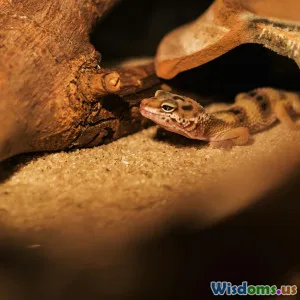
Common Reptile Myths Debunked by Herpetology Experts
10 min read Discover the truth behind common reptile myths with insights from herpetology experts. (0 Reviews)
Common Reptile Myths Debunked by Herpetology Experts
Reptiles, a diverse group including snakes, lizards, turtles, and crocodilians, inspire curiosity and fascination. Yet, their often misunderstood nature has spawned numerous myths and misconceptions that can affect how we perceive and care for them. Thanks to the dedicated work of herpetology experts, many of these myths have now been thoroughly debunked. This article dives into the most common reptile myths, separating fact from fiction to help reptile enthusiasts and the general public appreciate these remarkable creatures better.
Myth 1: Reptiles Are Cold and Unemotional "Cold-Blooded" Creatures
The term "cold-blooded," often used to describe reptiles, insinuates that they are emotionless and indifferent beings driven purely by instincts and an inability to feel pain or stress. Herpetologists clarify this is far from true.
Reptiles are ectotherms, meaning their body temperature depends on external heat sources, but this physiological trait doesn't limit their capacity for complex behaviors. Studies have demonstrated reptiles experience stress, can learn from experiences, and even show behaviors indicative of problem-solving and environmental awareness.
Take, for example, the neuroscience research on monitor lizards, which highlights their ability to remember paths and associate cues with food sources. Additionally, reptiles exhibit social behaviors—some species of turtles enjoy basking collectively, and certain lizards display bonding behavior between mates.
Dr. Kate Haimerl, a herpetologist at the Smithsonian Conservation Biology Institute, notes, "Reptiles have neurological structures involved in processing emotions and stress. It’s a misconception that their physiology renders them unfeeling. Recognizing their sentience encourages better welfare practices."
Myth 2: All Snakes Are Dangerous and Aggressive
This widespread myth is a major obstacle to appreciating snakes and leads to unnecessary fear and persecution. In reality, among over 3,000 known snake species globally, only a small fraction are venomous, and even fewer pose lethal risks to humans.
The majority of snakes prefer to avoid conflict and will only strike defensively if threatened. For example, the garter snake, a common pet and native to North America, is harmless and uses quick retreat tactics rather than aggression. The black rat snake, known for its large size, poses no venom risk and plays a vital role controlling rodent populations.
Herpetologist Dr. Jamie Watson explains, "Snakes are often unfairly labeled aggressive due to fear, but bites usually occur because people surprise them or provoke defensive behavior. Education on snake habits can transform fear into respect."
Moreover, snake venom varies widely—some species possess mild venom used primarily for hunting small prey rather than defense. In places like India and Australia, appropriate antivenoms and emergency treatments have greatly reduced mortality from snakebites.
A positive note is community-driven snake conservation efforts like those in Southeast Asia, where locals cooperate with herpetologists to protect endangered species while minimizing human-snake conflicts.
Myth 3: Reptiles Make Low-Maintenance Pets
This myth is a significant cause of many pet reptiles being neglected or abandoned. Reptiles require specific environmental conditions including temperature gradients, UVB lighting, humidity control, and species-appropriate diets.
For instance, green iguanas need temperatures ranging from 85°F to 95°F during the day with proper UVA and UVB lighting to synthesize vitamin D3—a necessity for calcium metabolism. Without it, they develop metabolic bone disease, often fatal.
The misconception that reptiles can survive minimal care originates from their slow metabolism and quiet demeanor, but neglecting their needs leads to severe health issues.
Joanna Williams, curator at a major reptile rescue center, states, "People choose reptiles thinking they are low-effort pets, but they require as much commitment and knowledge as cats or dogs. Responsible reptile ownership is about understanding their complex biological needs."
Providing real-world care examples:
- Ball pythons need hides and proper substrate to reduce stress.
- Temperate turtles require seasonal changes mimicking hibernation cycles.
Learning from reputable sources and consulting with certified herpetologists can prepare pet owners for successful reptile husbandry.
Myth 4: Reptiles Can Regrow Lost Body Parts Like Lizards' Tails Without Consequences
While it is true some lizard species can autotomize (self-amputate) their tails as a defense mechanism and subsequently regenerate them, this process is not without cost.
Tail regeneration is energy-intensive and typically results in a regenerated tail that differs in color, structure, and function from the original. The new tail usually consists of cartilage rather than bone and has altered scale patterns.
Research from the University of California shows that lizards rely heavily on their tails for fat storage and balance. Losing a tail negatively affects their locomotion, predator escape capabilities, and reproductive fitness.
Biology professor Dr. Alan Telford warns, "Tail loss is a last resort survival adaptation. While regeneration is impressive, it’s a biological trade-off that impacts overall health and energy budgets. Pet owners often don't realize the seriousness when their lizard loses a tail."
Preventing captivity stress and ensuring safe enclosures can reduce tail-loss incidents.
Myth 5: Reptiles Are Not Important to Ecosystems
Contrary to this myth, reptiles play vital ecological roles across various habitats. From controlling pest populations to serving as prey for many animals, their presence maintains balance in ecosystems.
For example:
- Snakes regulate populations of rodents and insects, helping reduce crop damage and disease spread.
- Turtles aid in aquatic ecosystem health by grazing algae and dispersing seeds.
- Crocodilians are apex predators, shaping food web dynamics and maintaining healthy fish populations.
In Florida, the decline of the gopher tortoise, a keystone species, threatens entire communities of organisms relying on its burrows for habitat. Herpetologists and conservationists emphasize protecting reptiles as essential to preserving biodiversity.
Jacksonville Zoo’s herpetologist Dr. Elisa Grant remarks, "Reptiles often reveal the health of an environment. Their loss signals ecological imbalance. Recognizing their importance supports conservation efforts worldwide."
Conclusion: Breaking Down Barriers Through Education
Myths surrounding reptiles are deeply ingrained yet increasingly being dispelled by ongoing research and public education from herpetology experts. Understanding reptiles beyond stereotypes allows better appreciation of their biology, behavior, and ecological significance.
For prospective reptile pet owners, debunking myths informs responsible care, improves animal welfare, and fosters a stronger human-reptile bond. For wildlife conservation, it nurtures empathy and policy decisions that protect these ecologically crucial animals.
As renowned herpetologist Dr. Phoebe Carter summarizes, "Educating the public is our best tool in protecting reptiles. Knowledge replaces fear with respect, myth with fact, and neglect with stewardship."
By embracing science-based perspectives, we can celebrate reptiles as fascinating, complex creatures deserving of attention and care.
References
- Haimerl, K., Smithsonian Conservation Biology Institute: Research on Reptile Neuroscience, 2021.
- Watson, J., Journal of Herpetology: "Snake Behavior and Human Interaction," 2019.
- Williams, J., Reptile Rescue Center Reports, 2020.
- Telford, A., University of California: Lizard Tail Regeneration Study, 2022.
- Grant, E., Jacksonville Zoo Conservation Publications, 2023.
Writer's note: This article incorporates scientifically grounded insights and up-to-date research to provide an authoritative guide debunking reptile myths.
Rate the Post
User Reviews
Popular Posts




















